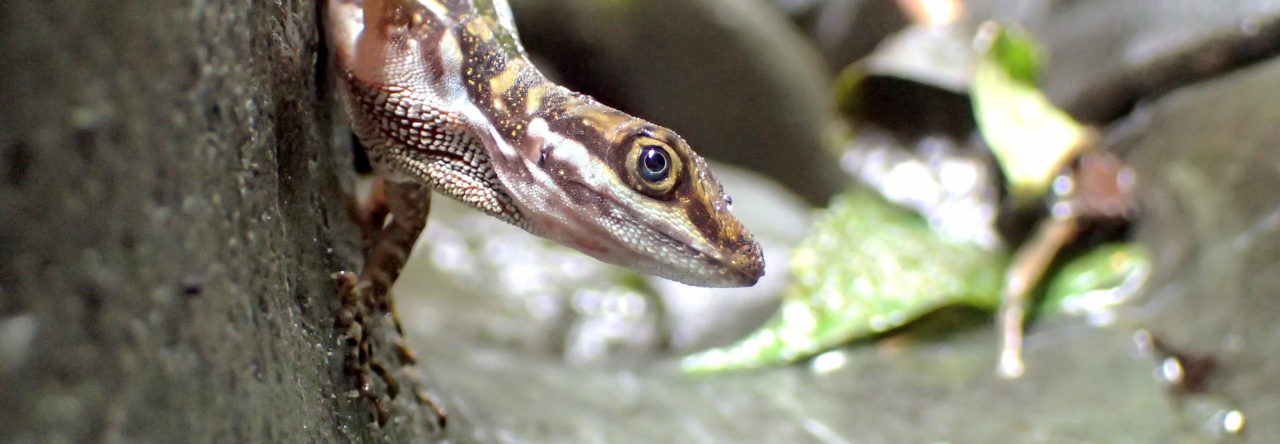Everyone’s favorite anole, A. proboscis, is featured in an article in the most recent issue of Lacerta. The article is chockful of beautiful pictures, such as the one above, but does have one shortcoming, at least for most of AA’s readers: it’s in Dutch! However, thanks to Harvard undergrad Jelle Zijlstra, we can provide a translation of at least part of the text.
Jelle writes:
One part that may contain unpublished observations is the following from p. 244 (my comments in brackets):
“During this study [an unpublished in manuscript form by Steve Poe and others] a juvenile anolis was also found. It is a male aged about 5 to 6 months (Santiago Ron, pers. comm. 2010), which is shown in figure 5. The pattern and colors seen in adults are already present in this young anolis. Although they are born with the nose flap [not sure what the thing is correctly called in English], it apparently grows larger as the animal becomes older. An adult male and adult female found in this study are shown in figure 6.”
He then discusses some observations by nature photographers which I’ll translate (pp. 244–5):
‘Not only has science rediscovered this anolis, a nature photographer and at least three (groups of) ecotourists have also recently found this species. From one find I have only found three photos on the Internet. There is one photo of an ecotourist with an adult male specimen on his head and two other photos of a local guide with the same anolis on his hand. The photos were taken in the vicinity of Mindo. I suspect that the value of the find was not completely recognized by the finder or the photographer, considering the type of photos and the captions of the photos.
Another group, which was aware that they were observing a special animal, also made several photos. Here too, it is a single adult male specimen found in the vicinity of Mindo. The precise site is unknown. After I contacted the photographer of these photos, she sent me a series of pictures of this male (figures 8 to 15).
The photographer, J. Georgine Surmont, also reports the ability to change color. The dark color phase is clearly to be seen on figure 13. The assumption of a color phase (roughly dark- or light-colored) is, just like in all other anolis species that can do this, primarily influenced by mood, temperature, and light intensity.
As a pleasant surprise, this anolis turned out to have also been recorded on film. As is usual for rare species, this is also the first known time that this species is on film. The video can be viewed on the website mentioned in the reference list [I found it at http://anolissen.nl/index.php?option=com_content&view=article&id=81&Itemid=80 where it is the first video from the top. The caption there also says that A. proboscis probably does not swim spontaneously, but it is clearly good at it.].
Finally, I’m much impressed by the work of nature photographer James D. Christensen. He resided for a substantial time in and around Mindo and there photographed the local wildlife. As a part of that, there have been systematic searches for anolises in this area and therefore also for occurrences of Anolis proboscis. According to his reports, he has found several males and females and photographed them in their natural habitat. He also reports color changes that can occur in a very short time. A comparison of the photographs known to me shows that the species is also somewhat variable in color and pattern.
What struck me after seeing a number of photos of different males is that the form of the nose flap is variable. In some specimens, the edge is oriented upward, in another it is fairly straight and oriented towards the front, and in a third case the flap is oriented downward.’
The rest of the article apparently mainly discusses data from Yánez-Muñoz et al. (2010) and other sources and concerns the range and conservation status of the species.
- Evolution in Real Time on Lizard Island - March 23, 2025
- Spider Snags Adult Anolis osa - March 22, 2025
- An Homage to the Green Anoles of New Orleans - March 21, 2025



Wes Chun
Thank you for posting the article by Yanez-Munoz et al. In early 2006, Fernando Ayala (QCAZ), Rosario Castaneda (GWU), and I visited Mario Yanez at the Museo de Ciencias Naturales in Quito. Mario was a mine of information about anoles in Ecuador and where to find them. He had a way of explaining things in a very clear manner (even for someone like myself who can barely speak Spanish). Unfortunately, we were unable to find a single specimen of Anolis proboscis. We even went to the type locality of Cunuco, where we were told that the ‘anolis colibri’, or hummingbird anole, was usually seen during the dry season.
Hans Recknagel
Is the nose flap really inter-individually variable? To me it seems that the nose flap is quite flexible (you can watch it in the video at 00:12 when the flap touches the leave), maybe the anole is able to move it actively? I am sure females and rivals would be impressed by being faced not just with headbobs but also with “flapbobs”
Jonathan Losos
Very good question, Hans. They definitely can move their horns. The horns grow as they get larger, but other than that, the extent of their variability remains uncertain.